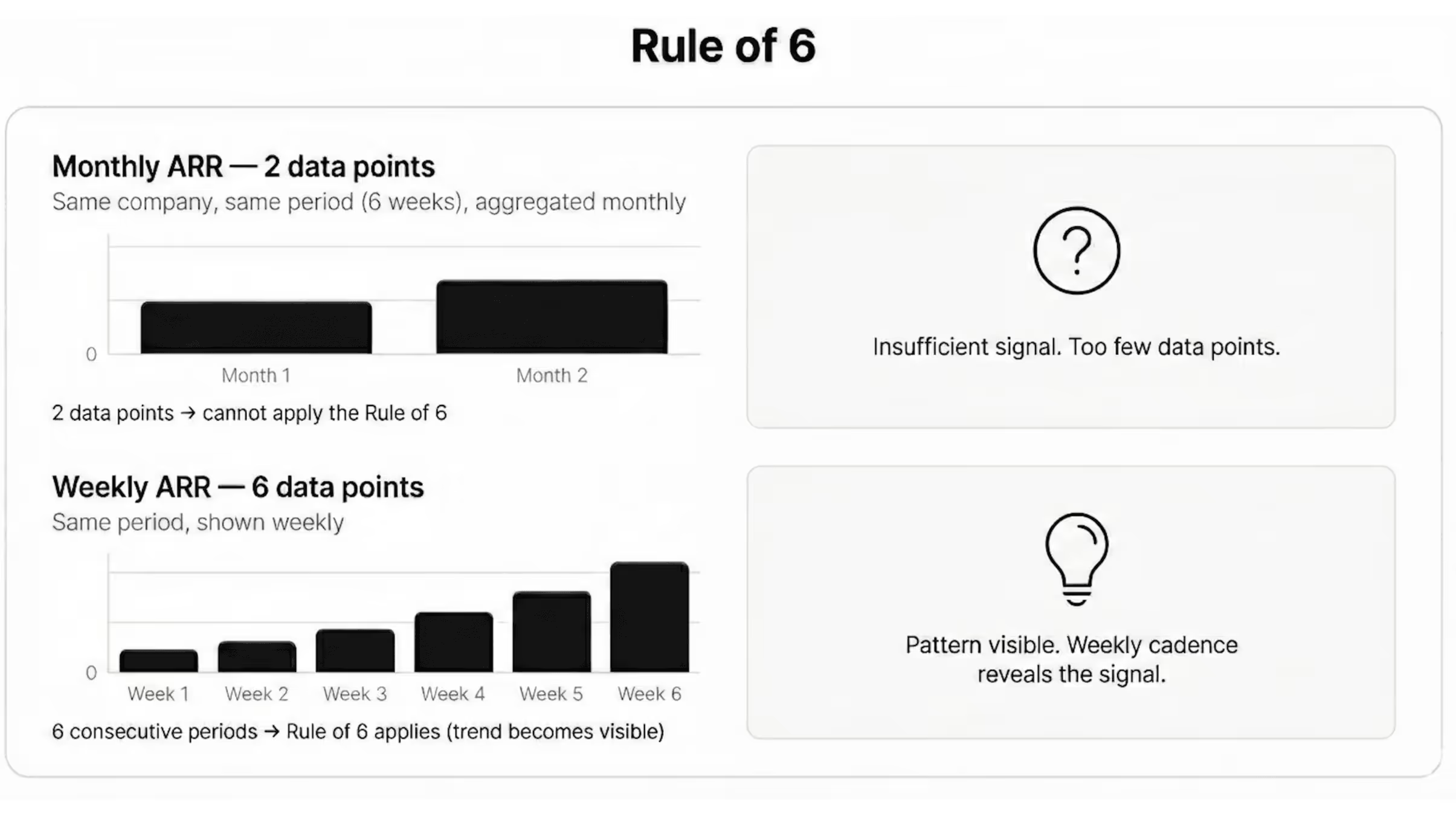By some estimates on Pitchbook, venture capital dry powder has increased up to 11x in the past 6 years in Southeast Asia. The amount of competition has increased at all levels intensely as large internationally renowned investors (Naspers, Founders Fund, GGV Capital, Vulcan Capital, etc) focus on SEA, while prominent local investors and founders either set up (Tanglin Venture Partners, Asia Partners, Insignia, etc), or double down with larger funds (Strive, Vickers, Golden Gate Ventures, Openspace, etc).
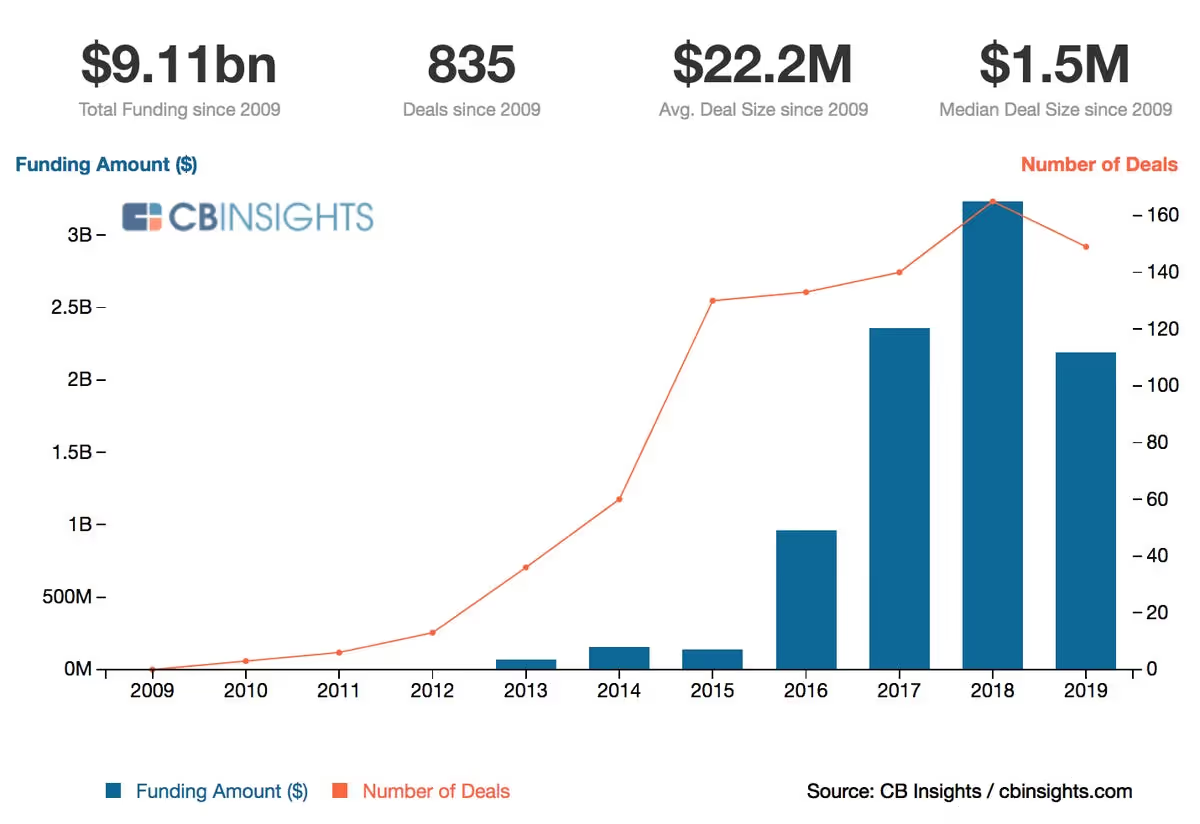
To say competition among venture funds in SEA has increased across the board is an understatement, and it is transforming venture capital and startup entrepreneurship during a very exciting time.
I spent the last 9 months traveling across Southeast Asia, Europe, and the Bay Area talking to venture funds to understand where we are at, and how venture funds themselves are transforming all over the world to cope with increased competition.
I wanted to answer one question: How will venture fund strategies adapt to generate above-market returns?
How will venture fund strategies adapt to generate above-market returns?
Funds fundamentally aim to allocate capital into the best-performing companies. You have three options to outperform the competition and be in the position to invest in the best companies:
Add value, source better, build it.
I looked into what the different factors were and who was playing in which strategies, breaking them down below. Value-Addition honestly deserves an article of its own, and I touch on the high-level of the various arms of Value-Addition in the second half of this article.
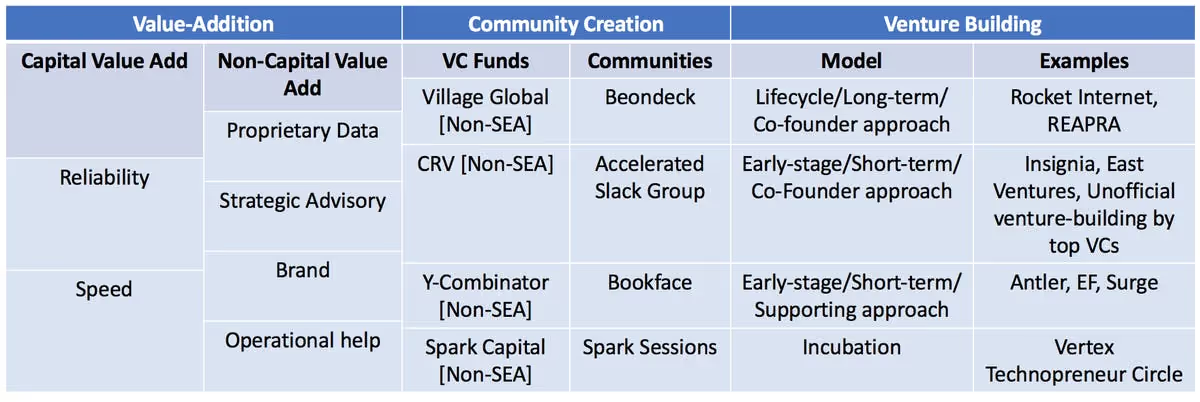
Breaking down Community Creation
The name of the Venture Capital game is informational asymmetry; who is building the best startups in stealth mode, where are the best would-be entrepreneurs, how do funds become the first fund potential entrepreneurs think of when raising money?
Funds build communities that potential and current founders turn to to find like-minded people, and support, in the aim of turning these communities into avenues for lead generation for potential investment leads, as well as to build their reputation as a thought leader in the field, as Spark Capital does with Spark Sessions. CRV also uses their Accelerated Slack Group of mainly undergrads to get information on new consumer trends among Gen Z's.
Breaking down Venture Building
If you can't find it, build it. This has been an attitude taken by a number of venture funds who find that they hold the keys to a number of important factors of building a highly successful company: Access to talent, capital, and understanding of what needs to be built.
On the highest spectrum of venture building involvement, companies like Rocket Internet have famously built and sold billion dollar companies like Lazada in SEA from scratch to acquisition. These funds tend to own the vast majority of the cap-table.
Moving downwards, funds like Insignia and East Ventures have been known to work with promising founders on the initial idea, provide the initial Seed capital, and with members of their investment team joining as key C-suite early employees. These funds typically then continue their involvement with the company as an investor into their later rounds and typically own outsized but not significant majority stakes in the company.
Working in a similar manner, though on a shorter-term basis, companies/programs like Antler, EF, and Surge, work with individual founders in a programmatic manner, and help them find cofounders to start companies together, investing an initial pre-Seed/Seed capital, with no guarantees of a follow-on investment. Post-investment/program, the founders are typically left to build their companies, with some support from their investors (who typically generate hundreds of companies through this model).
Breaking down Value-Addition
While googling "VCs that add value" provides several rude memes created by jilted founders, there are some great funds that add incredible value to their portfolio companies.
There are two main ways (capital and non-capital value-add) that funds maintain a competitive edge over others to attract the best companies to accept their money on the cap-table. Many funds, especially in the US and Europe develop very specialized theses and are known in the market for their knowledge and ability to deploy help and capital in specific niches (Point Nine Capital and Redpoint in SaaS is a great example).

Breaking down Capital Value-Add

Founders like two things in their investors: They invest fast and they can be reliably counted on to support me with capital.
Investing fast requires shortcutting the typical investing process, either through an algorithmic/checklist approach or a deliberate portfolio building approach.
Quant/Checklist Investing
Quantitatively driven investing approaches will inevitably disrupt venture capital. Ryan Caldbeck's (CEO of CircleUp) famous Twitter storm on how quant-based investing is already disrupting CPG venture investing sparked my initial interest into quant-based venture investing. By automating the assessment of large stores of data, typically operational performance data on company performance (G.Analytics, financial, cloud usage, etc), funds are able to get to an investment decision within days, if not minutes. Credit financing companies like Clearblanc and Brex are also getting into this space in big ways, and are likely to compete with VC funds in providing capital to startups.
Checklist driven approaches set aside clear and narrow criteria for investing, typically based on qualitative filters. Alumni Venture Group co invests alongside only top-investors and does not negotiate terms, allowing for fast investment decisions to be made. Correlation Ventures utilizes data science to identify top companies based on a variety of metrics, including who previous and existing investors are to co-invest into deals, investing in as little as 2 days.
Portfolio Investing
Portfolio investing strategies rely on the fact that venture-like returns have to rely on the vast majority of the investments failing. Aptly captured by 500 Startups and the Hustle Fund's investment thesis, instead of optimizing for finding the one or two companies that will become unicorns, funds invest widely into hundreds of companies, and early with small checks, wait to see if there have been significant successes and double-down on the winners. This is backed by research showing that the best funds invest widely and have more strikeouts than mediocre funds.
Reliability
Some funds like to tout their ability to be 'life-cycle investors', being able to support the financing needs of founders from Seed to IPO. The argument is that this framework allows founders to focus on executing on their business and that their investors would have the capability and capital to support them at every stage of the way, and with increasing reliability given the accumulated relationship over time between the founder and the investor. Life-cycle investors may also sometimes have flexibility in the ticket size, valuation and rights under the investment agreement. In SEA, such funds include Softbank Ventures Asia, GGV Capital, Global Founders Capital, and Sequoia.
Breaking down Non-Capital Value-Add
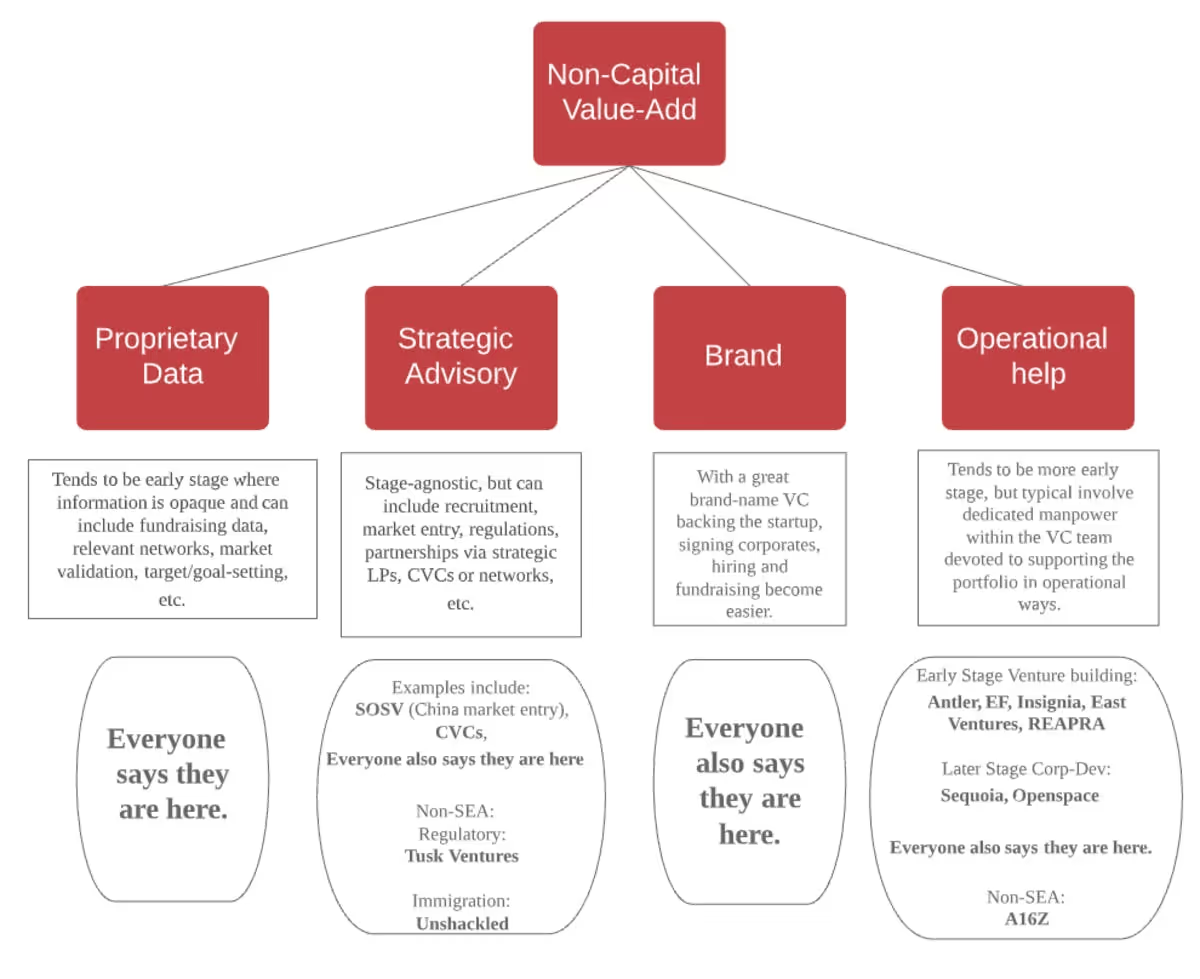
Proprietary Data
With venture capital being an asymmetrical game, touting access to proprietary data is an excellent moat, though hard to gauge between funds (or publicly rank - Because I'm no hater - y'all VCs are my friends).
Such information can include helpful fundraising data, relevant networks, market validation, and more operational data like target/goal settings (i.e. "Your CAC needs to be XYZ at this stage in this market, your sales efficiency needs to improve by x% given comparable data from our portfolio companies and the companies we see.")
Strategic Advisory
All investors add value to their portfolio companies and founders. Some hold particularly strategic positions because of the specific niche they hold. SOSV's China accelerator, in particular, has found a niche in startups looking to break into the Chinese market from the outside. SOSV's HAX arm, and TNB Aura, provides specific expertise in the hardware space, a notoriously hard area for VC funds, with deep domain experts and former hardware founders to call upon.
CVCs have traditionally played an important role here for their access to the distribution channels, expertise and business units of their larger corporate parent.
Internationally renowned funds like Founders Fund, Naspers, Softbank Asia Ventures will also find themselves in an advantageous position to act as an informational and network bridge between global business models and networks that would have increasing relevance to SEA as the ecosystem matures.
Outside SEA and in particular in the U.S., some funds have carved out very specific niches to cater to very specific business models. Tusk Ventures focuses on industries that are looking to disrupt heavily regulated industries (ride sharing, insurance, etc), and works with lobbying groups and politicians to ensure a smooth-sailing for their portfolios. Unshackled VC focuses on providing immigration advice to help immigrant founders get access to the US market by providing help with visa and migrating into the US, with the thesis that immigrant founders hold large untapped potential, especially if they are trapped outside the US for immigration reasons.
Brand
When startups do not have much to show, perception can be everything. Some startups rely heavily on outside validation in the form of the investors they have on their cap-table to show other investors, potential senior hires, and potential corporate clients, of their legitimacy and as a weapon to wield in conversations.
Operational help
VC funds have been increasingly moving to a model where they are able to work more closely with their portfolio companies to help them certain parts of their companies. A16Z famously pioneered this model at scale, with entire teams set up across different functions, with experts in marketing, business development, finance and recruiting on the A16Z team working hand in hand with their portfolio companies. Among other events, A16Z would organize matchmaking events at their offices for their portfolio companies and large corporations. Openspace Ventures employees VPs of Product, HR, Marketing, etc to assist their portfolios with strategic and operational issues - key hires, platform decisions, etc. Sequoia has a similar approach with their own team of VPs & Directors of Engineering and HR.
As competition between venture capital funds continues to heat up, especially with internationally renowned VCs moving into what was a previously regional-only funding scene, I expect funds to increasingly compete in one or more of the above ways. My hunch is that as the main bottleneck for SEA remains talent and a fragmented market, funds will increasingly turn to position itself with a strategic go-to-market advisory niche or venture build (an avenue I am bullish in and have written here before). Either way, the nascent VC industry of SEA is about to transform itself once more and there are exciting times ahead. With a buffet of capital sources, it is a great time to be a founder in Southeast Asia.
This article is written by Chia Jeng Yang
Thanks to Sahib Singh from Leapfrog Investments for thoughts/comments.




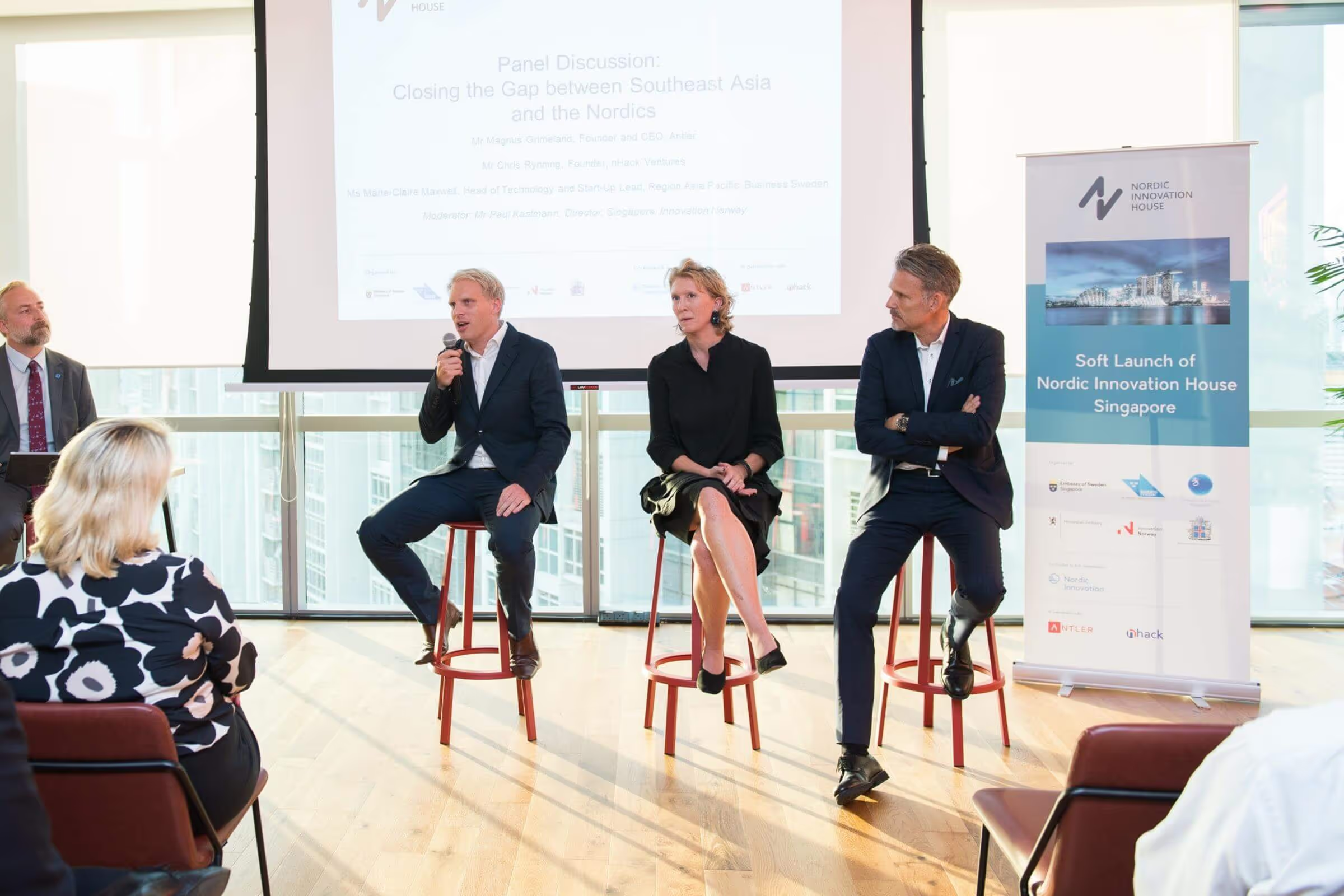




.jpeg)

